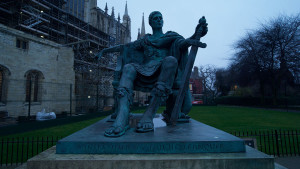Why are there so many churches if Christians believe in the same God and read the same Bible? Harold Harker finds out.
After Jesus’ death, persecution of His followers—often by Jewish religious authorities—forced them into the farthest corners of the then known world. They took with them the great story of the life, death and resurrection of Jesus, and the hope of His soon return.
The apostles, particularly Paul, Barnabas, Silas, Luke and Timothy, established local churches across the world and appointed elders and deacons (positions that still exist in many churches today) to superintend them. As well as attending to the ecclesiastical aspects of worship, they distributed food and goods to the needy.
So the early church came together every day, but the Sabbath was their special day of worship. This practice, also observed by Jews, demonstrated their total acceptance of the Ten Commandments given by God.
As time went by and the apostles and disciples passed away, these elders—sometimes called bishops—began to assert more authority. Finally, the bishop of Rome assumed pre-eminence and began to transform the simple church into something more like a kingdom in structure and authority.
Simultaneously, as the growing church encountered pagans—as non-Christians were called—it assimilated many of their practices, in an effort to make the transition to Christianity easier (see “ ‘pagan’ Christian practices,” below). Naturally, the beliefs of the early church were soon compromised and adulterated. A general slide from the beliefs and practices of those Jesus kept and taught gained pace, reaching its lowest point in what is historically called the Dark Ages.
During this period, the Bible was in the possession of the literate elite, the church had become corrupt with power and religious leaders expected complete, unquestioning acceptance of its biblical teachings as presented to the common people.
Lead Up To The Reformation
By the fourteenth century, many Bible scholars, with a deep passion for God, were making a stand for truth:
- John Wycliffe, also known as the “Gospel Doctor” and the Morning Star of the Reformation, made a courageous stand to rectify the problems and corruptions he saw in the church.
- In Bohemia (an area currently located in the modern-day Czech Republic), John Huss—influenced in part by Wycliffe’s writings and teachings—paid for such a stand with his life.
- Girolamo Savonarola in Italy made a stand to bring purity and truth back to the church.
- In England, William Tyndale took up the cause and endeavoured to have the Scriptures translated in the language of the people—and was martyred for his effort.
- The Albigenses of southern France and the Waldenses of alpine northern Italy were noted for their stand for the Holy Scriptures amid harsh persecution. (The Waldensian Church survived through the centuries until 1975, when it joined the Italian Methodist Church to form the Union of Waldensian and Methodist Churches.)
Then like a brilliant sunrise chasing away the darkness, Martin Luther burst onto the scene. His desire was not to form a separate church, but to have the church stay true to Scripture and be more like the early church. His efforts were neither accepted nor appreciated by church leaders. Excommunicated, he made his historic stand alone for truth. His famous words echo through history: “Here I stand, I can do no other. . . . So help me God.”
Why So Many?
Luther’s actions started what is now known as the Protestant Reformation, a protest movement against church practices of the time, and which aimed to restore the faith and practice of Jesus Christ and early apostles to the established church, and to follow the Scriptures as the only authority.
As spiritual leaders emerged, bringing with them new biblical insight and understanding, people across Europe flocked to them. It is the teachings of these men that formed the foundations of many of today’s churches. They were endeavouring to unearth biblical truth and follow it, according to their conscience, and after the example of the early church. Their conclusions formed the doctrinal foundations of many Christian denominations today.
Bible societies were formed in the nineteenth century with the aim to take the Bible (printed in different languages) to the world. Along with this movement, missionary societies were formed, heeding Jesus’ call to “Go and make disciples of all nations” (Matthew 28:19).
People like Joseph Wolff, Manuel Lacunza and Joseph Irving began proclaiming that Jesus Christ would return to this world according to His promise. In the United States, the burden to share this belief with the world fell heavily on Baptist farmer, William Miller.
From this great religious awakening, a number of religious bodies were formed, among them the Seventh-day Adventists (publishers of Signs of the Times). As their name implies, Seventh-day Adventists believe in the soon return of Jesus Christ (adventist) and maintain that Saturday as the seventh day of the week is the Sabbath, as Jesus taught and lived, and seek to restore that to Christian consciousness and practice.
Choices
The Bible book of Revelation speaks of a message to go to all the world just before Jesus Christ returns to earth: “I saw another angel flying in midair, and he had the eternal gospel to proclaim to those who live on the earth—to every nation, tribe, language and people. He said in a loud voice, ‘Fear God and give him glory, because the hour of his judgement has come. Worship him who made the heavens, the earth, the sea and the springs of water’ ” (Revelation 14:6, 7).
God’s last message to the world begins with the eternal Gospel—that Jesus Christ by His self-sacrifice, completely saves us from our sin, and that nothing we can do can add to His salvation, which is offered as a gift. We are to give glory to God and worship Him.
So when looking to join a church for the family and fellowship it offers, consider also how closely it follows the Bible and its interpretation of itself—sola Scriptura—the Bible and the Bible only. Seek the truth as Jesus taught it as you wait for His return.





